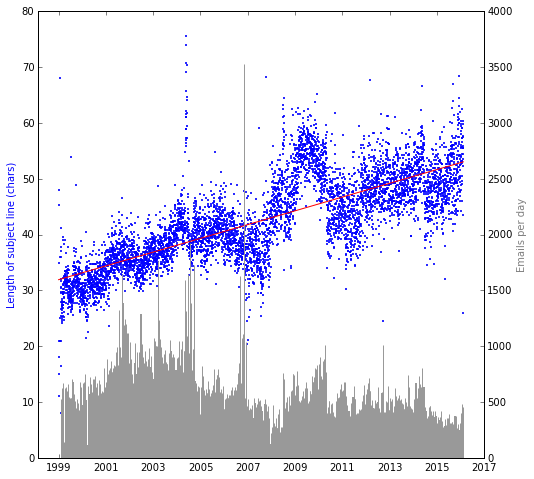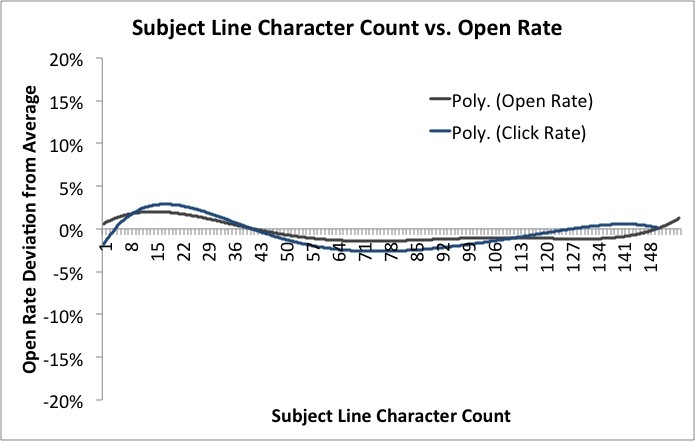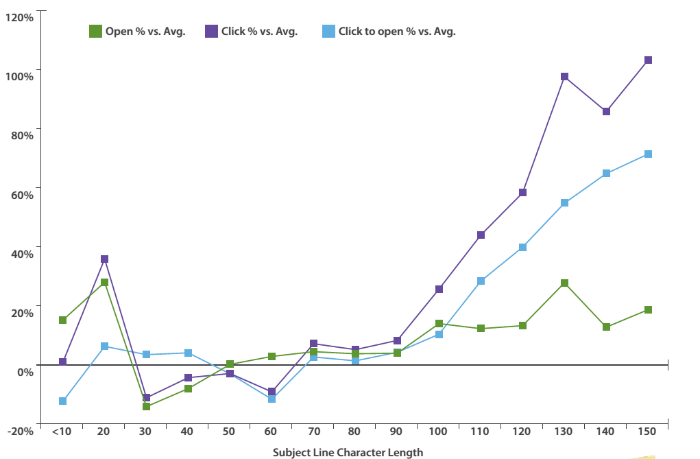There is a question: why e-mail topics become longer, and what does it affect

In our blog, we write a lot about creating emails and working with e-mail. We have already discussed the complexity of the fight against spam , the future of email, the protection of postal correspondence , as well as the techniques of working with email , used by the leaders of large IT companies.
Today we will look at another interesting topic - why, over time, the topics of letters that people send to each other become longer? Online journalist Danny O'Brien in his blog presented a mini-study designed to answer this question. We present to your attention an adapted translation of this material.
')
What's happening
According to the journalist, he tried to find confirmation of his theory that the subject of email messages became longer with time. O'Brien arrived at this conclusion by surprisingly finding the short headers of old emails from 1998.
It has two huge archives of incoming and outgoing e-mails: the first one contains letters from 1999 to 2007, and the second from 2007 and on. In total, they contain 2,732,487 letters. The journalist measured the length of the topic of each of these letters, entered them into the database, indicating the date of receipt or dispatch, and made a chart, where the average length of letters per day is marked.

The length of the letter / Number of letters per day
From the trend line, you can see that the length of the headings does increase by an average of 1.2 characters per year, starting in 1999.
So what's the deal? Did this happen only with his letters? Maybe only the interlocutors of the journalist such talkative? Or an error has crept into the calculations?
O'Brien laid out the code that he used to create the resulting graph - with its help, anyone can check the tendency to increase the length of the messages in his own mailbox. This code can be applied to Maildir and mbox formats or to the database of the notmuchmail mail system, and you can build a graph using matplotlib . Available for download and own base O'Briana.
What is the reason
Here are some possible explanations that the journalist found. This trend may be associated with an increase in mass mailings, in which the title of the letter indicates the name of the mailing list (for example, “[mylist] hello to everyone”). In this case, you can remove the square brackets or letters, in the headers of which the name of the newsletter is indicated.
The reason may be the increase in the number of marketing letters (not necessarily spam), their parameters differ from the "traditional" letters that people write to each other. It's time to refer to the relevant literature: people who are engaged in mass distribution of marketing letters, really care about the length of the letter .
In one of these studies, 9 million emails were analyzed. The average length of those 9 million emails sent in February 2015 was 41-50 characters , which is slightly less than or equal to the length of the headers in my mailbox.
Increasing the length of the headers of letters can be associated with an increase in screen size. If you have more space to write the subject of the letter, you will probably want to fill it out. It is worth making a parallel with this statistics on the resizing of the browser window from the statcounter resource.
It is difficult to talk about a strict causal relationship between these values, but it is likely that some changes in the resizing window of the browser window may correlate with a strange jump on my schedule in the period from 2009 to 2011 (although perhaps this concerns only my data) .
On the other hand, if the size of the monitor matters, then it is surprising that an increase in views from mobile phones did not affect the curve on the O'Brien graph. Or it affected (by reducing the angle of inclination of the trend line): he could filter the messages sent from the mobile and analyze the length of their headers.
And finally, probably in our time, people just write longer letter headers. Check this assumption is difficult: it would be nice to confirm, say that the average word length in the message also increased. Although it would be strange if this happened so consistently.
Does the length of the topic affect the probability of reading the letter?
About a year ago in the Pechkina blog on Habré we published interesting statistics on how certain indicators of letters affect their effectiveness. Then it turned out that the length of the letter subject field does not have a particular impact on its effectiveness. Mailchimp’s email service team conducted a survey to find out if the length of the email subject is affecting its effectiveness. Analysts examined 12 billion letters sent in 2012 to see how an increase in the length of the subject field affects the opening rate of the letters and the number of clicks on the links inside it. The results suggest that the length of the topic does not affect these indicators:

Representatives of the company Adestra conducted their study, which confirmed the fact that the discovery rate does not depend on the length of the letter. As for the clicks and the number of users who clicked on the links after the letter was opened, it turned out that the longer topics of the letters show the best results:

From the point of view of efficiency, a much more important factor is the personalization of the very topic of the message - according to the data of the same Adestra, a letter with a personalized topic will be opened with a probability of 22.2%.
Source: https://habr.com/ru/post/282155/
All Articles